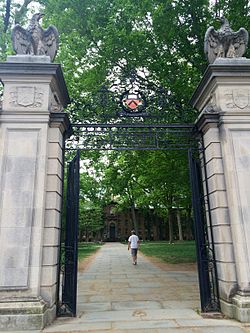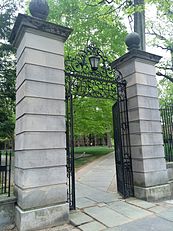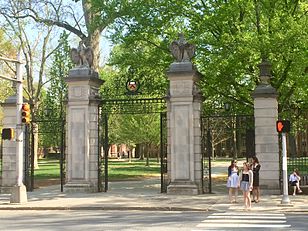
Princeton University is a private Ivy League research university in Princeton, New Jersey. Founded in 1746 in Elizabeth as the College of New Jersey, Princeton is the fourth-oldest institution of higher education in the United States and one of the nine colonial colleges chartered before the American Revolution. The institution moved to Newark in 1747, and then to its current campus, nine years later. It officially became a university in 1896 and was subsequently renamed Princeton University.
Earl of Harrington is a title in the Peerage of Great Britain that was created in 1742.
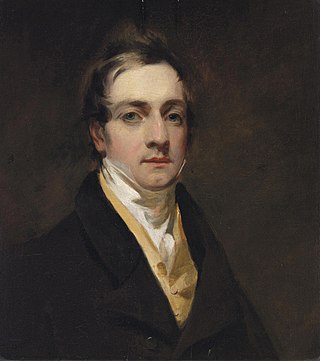
Peter Van Brugh Livingston was a Patriot during the American Revolution who was a wealthy merchant and who served as the 1st New York State Treasurer from 1776 to 1778.

The Princeton Reunions are an annual college reunion event held every year on the weekend before commencement at Princeton University. Known simply as "Reunions", this event brings back to campus upwards of 25,000 alumni and guests for a four-day celebration featuring large outdoor tents, elaborate costumes, sporting events, alumni and faculty presentations, fireworks, and bands from rock to swing.

The Blithewold Mansion, Gardens and Arboretum is an arboretum of 13 hectares, located at 101 Ferry Road, Bristol, Rhode Island, midway between Newport and Providence, Rhode Island, on Bristol Harbor with views over Narragansett Bay. It includes a mansion, with a 4 hectares lawn and over 300 species of woody plants in its arboretum and gardens, including both native and exotic species.

The Princeton University Band serves as the marching band and pep band of Princeton University. Like most other Ivy League bands, it is a scramble band. To members and fans, it is often known as the PUB or simply The Band. Many alumni refer to it as the Tiger Band.

Nassau Hall, colloquially known as Old Nassau, is the oldest building at Princeton University in Princeton, Mercer County, New Jersey, United States. In 1783 it served as the United States Capitol building for four months. At the time it was built in 1756, Nassau Hall was the largest building in colonial New Jersey and the largest academic building in the American colonies.

Abraham Bedford Venable was a Virginia lawyer, planter and politician who served in the U.S. House of Representatives and briefly as U.S. Senator, as well as in the Virginia House of Delegates.
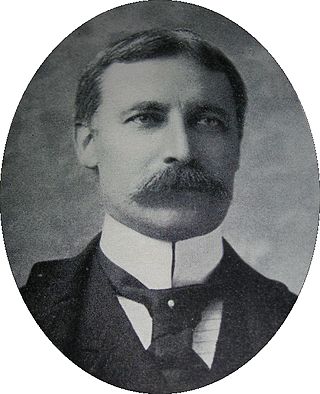
Moses Taylor Pyne, was an American financier and philanthropist, and one of Princeton University's greatest benefactors and its most influential trustee.

The Nassau Inn is a full-service hotel in downtown Princeton, New Jersey, United States. It first opened at 52 Nassau Street in 1769 in a home built in 1756. The Inn experienced British occupation during the American Revolution and played host to members of the Continental Congress when it met in nearby Nassau Hall. In 1937, the original inn was demolished to make way for the Palmer Square development and a new, larger, inn opened at 10 Palmer Square in 1938. The hotel's restaurant, the Yankee Doodle Tap Room, has a large mural by Norman Rockwell, depicting Yankee Doodle, behind the bar. It is within walking distance of Princeton University.

The Remah Synagogue is a 16th-century Jewish synagogue and the smallest of all historic synagogues in the Kazimierz district of Kraków, Poland. The synagogue is named after Rabbi Moses Isserles (c.1525–1572), known by the Hebrew acronym ReMA who's famed for writing a collection of commentaries and additions that complement Rabbi Yosef Karo's Shulchan Aruch, with Ashkenazi traditions and customs. It is currently one of two active synagogues in the city.

Edwin Manners was an American lawyer, property owner and diarist. He graduated from Princeton University with a Bachelor of Arts in 1877, went on to earn a degree in Law at Columbia University, and was accepted to the bar. He became involved in projects to improve Jersey City, such as a project improving the water supply. He continued as a lawyer, besides his municipal interests, and spent a good deal of time managing his property. He also kept a journal detailing his life over a 21-year period, from 1893 to 1913.

University Hall is the first and oldest building on the campus of Brown University in Providence, Rhode Island. Built in 1770, the building is one of only seven extant college buildings built prior to the American Revolution. According to architectural historian Bryant F. Tolles Jr., the structure is "one of the genuine icons of early American collegiate architecture."

The Van Wickle Gates form the ornamental entrance to Brown University's main campus in Providence, Rhode Island. The gates stand at the intersection of College Street and Prospect Street at the crest of College Hill. Dedicated on June 18, 1901, they stand as a symbol for the campus and its 259-year history.

The President's House, also known as the John Maclean House, or simply the Maclean House, in Princeton, Mercer County, New Jersey, United States, was built to serve as the home of the President of the College of New Jersey, which later became Princeton University. It was completed in 1756, the same year as Nassau Hall. United States Founding Father John Witherspoon lived here from 1768 through 1779, during which time he served as a delegate to the Continental Congress and signed the Declaration of Independence. George Washington occupied Maclean House in January 1777, during the Battle of Princeton and in 1783 while Congress met in Nassau Hall.
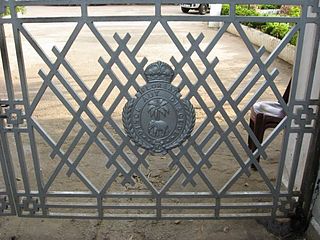
The Boake Gates at Royal College Colombo are three entrances to the main building along Rajakeeya Mawatha in Colombo. Erected in 1938, the gates stand as a symbol for the college's traditions and culture.

East Jersey Old Town Village is an open-air museum located in Johnson Park in Piscataway, New Jersey. The Village is a collection of Raritan Valley area historic buildings and includes original, reconstructed, and replicated 18th and 19th century vernacular architecture typical of farm and merchant communities of Central Jersey. It is home to a permanent exhibition about Raritan Landing, an 18th-century inland port once located just downstream on the river. Since 1989, the Middlesex County Office of Arts and History has had responsibility for the village.
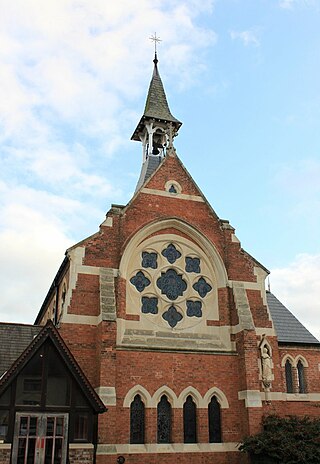
St Mary Immaculate is an active Roman Catholic parish church in the town of Warwick, England. It lies to the south west of the town on West Street outside the West Gate. The church was opened on 12 May 1860. The architect was Edward Welby Pugin, eldest son of Augustus Pugin. The church is built in red brick and Bath stone in the Decorated Gothic style and is a Grade II listed building. The builder was William Gascoyne (1827–1902) of Leamington. St Mary Immaculate was one of the first churches in England to be dedicated to the Immaculate Conception after the definition of the dogma in 1854. It was the first permanent Roman Catholic church in Warwick. The church was consecrated on 15 June 1939. The presbytery was built at the same time as the church but has been altered.
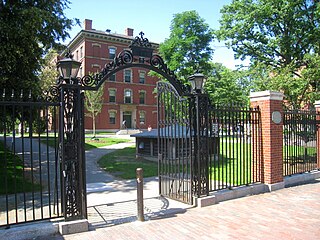
Bradstreet Gate, on the perimeter of Harvard Yard in Cambridge, Massachusetts, is a wrought-iron gate opposite Memorial Hall. In 1997 it was dedicated to Anne Bradstreet on the 25th anniversary of female students living in Harvard's freshman dormitories. A plaque with a quote from one of Bradstreet's poems was added in 2003.
John Henry Smyth was a Whig member of Parliament for Cambridge University from 9 June 1812 until his death.
